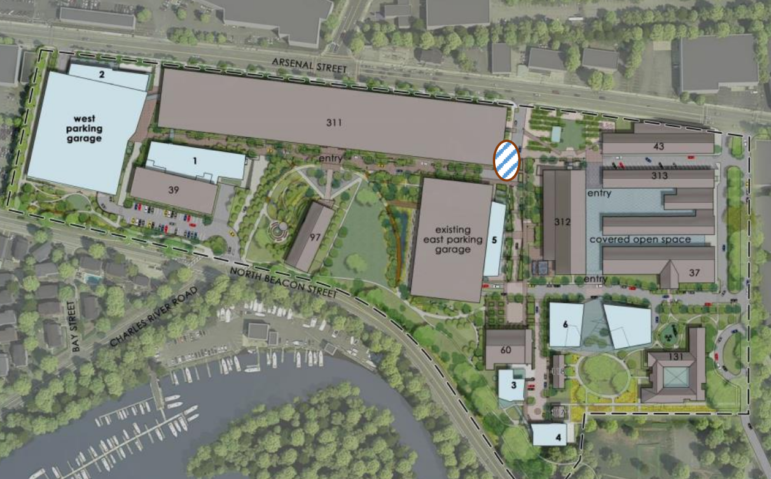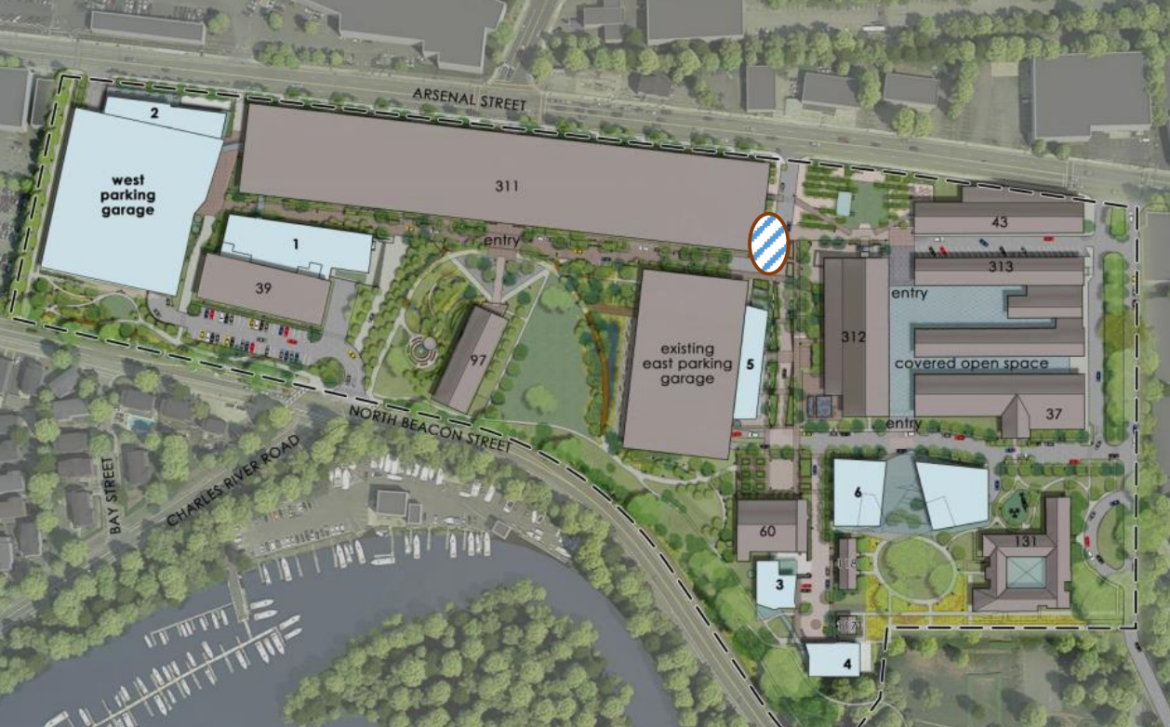
The U.S. Army has come up with a plan to remove contaminated soil from the former military site, which is now the Arsenal on the Charles. The public can submit comment on the proposed plan until April 14, 2021.
The area where the contaminated soil is located is by 311 building on the Arsenal on the Charles site. Building 311, the long building along Arsenal Street, is home to Athenahealth, and used to be home to Boston Sports Club. The contamination is near the entry driveway that runs between Building 311 and the building where the Mosesian Center for the Arts and Panera Bread are located.
A report with a proposed action plan has been created and released by the Army. See the report by clicking here.
“In coordination with Army, EPA and MassDEP, it was determined that these soils should be removed …” the report reads.
The study estimates there is about 2,000 tons of soil that would need to be removed. The area where the contamination is mostly covered by a sidewalk next to Building 311 and and parts of Kingsbury Avenue between Arsenal Street and Wooley Avenue. There is also a small amount of landscaped area within the sidewalk and next to Building 311.
During a construction project in August 2015 to work on utility infrastructure east of Building 311, subsurface soils containing “elevated levels of contaminants, notably PCE and TCE, were discovered.” The owners at the time, Athenahealth, notified the EPA and the Army. A study found the soil was limited to a shallow area of the soils, generally less than 5-feet in depth, at the east end of Building 311.

Studies conducted by the Army in 2018 and 2019 found that “while elevated levels of TCE and PCE exist in sub-slab vapor beneath the southeast portion of Building 311, indoor air concentrations of these compounds do not currently pose an unacceptable risk to human health.”
The study concluded, however, that the levels could become hazardous for people inside Building 311 in the future, and contaminants could also leach into the groundwater and move to different areas. That could lead human contact to vapors or direct contact.
“Construction workers could be directly exposed to the impacted soils during future excavation and construction activities,” the report reads. “Passerby and occupants of nearby buildings could also be exposed to fugitive dust and vapors during future excavation activities.”
This is not the first time that contaminated soil would be removed from the site. In the 1990s, about 10,500 tons of material was dug up and disposed of off-site. Also, in 2006, contaminated soil was removed during the construction of the new parking garage on the west end of the Arsenal on the Charles site.
The Town of Watertown sent out the following announcement, with information for how to comment on the proposal:
Non-Time-Critical Removal Action at Army Material Technology Laboratory at 311 Arsenal Street
NOTICE OF AVAILABILITY AND PUBLIC COMMENT PERIOD
NON-TIME·CRITICAL REMOVAL ACTION
FORMER ARMY MATERIAL TECHNOLOGY LABORATORY, WATERTOWN, MA
The Department of the Army, in coordination with state and federal environmental regulatory agencies, is announcing the public availability of the Engineering Evaluation /Cost Analysis (EECA) for the Non-Time-Critical Removal Action at the former Army Material Technology Laboratory (AMTL) located at 311 Arsenal Street in Watertown, Massachusetts (Building 311). The EECA recommends excavation and removal of soil containing chlorinated volatile organic compounds. The soil that is subject to the removal action is currently localized beneath private sidewalk and roadway at the east end of Building 311.
PUBLIC COMMENT PERIOD: The EECA is available for public review, and the Army will accept comments during the 30-day public comment period held from March 15, 2021 through April 14, 2021. Public comments submitted in writing must be postmarked or e-mailed no later than April 14, 2021. The EECA can be reviewed at the Public Comment Reviews as the AMTL FINAL DRAFT EECA at: https://dcsg9.army.mil/brac/.
Please email comments to Mark Brodowicz at: AMTLComments@eheinc.com.
or mail to:
Environmental Health & Engineering, Inc.
180 Wells Avenue, Suite 200, Newton, MA 02459-3328
Attn: AMTL Comments

This is an unforgiveable disgrace and a stain on Watertown.
Where were our health authorities? Are these the same ones who removed basketball hoops in playgrounds when it was found that some players were not wearing masks last year?
There was another nearby area of contamination – not at the Arsenal site itself – that was simply covered with soil. This is well-known.
One wonders how many other ticking time bombs are out there in Watertown and elsewhere.
Probably the same guy that made the kids stop playing cricket on the baseball field because they didn’t have a permit.
And is there something buried by the government in the back near the River? That should also be addressed.
There is a deep and long history on that land. It was an active US Army munitions arsenal from the Civil to the Vietnam Wars. It was a research center for many more years AMMRC. Many of my classmates and I worked there in HS on a Watertown/AMMRC student program in the 1970’s. There was a decommissioned nuclear powered reactor there that was active in the early 1960’s that is now long gone. I don’t think that the Watertown Health Department had much to do with any of that. It was a superfund cleanup site when the Army left the property. I remember that they had one of the few plow trucks large enough and powerful enough to clear the Watertown roads after the blizzard of 78.
Many Watertown residents worked long and hard to get the Arsenal cleaned up, and, as the article says, a lot has been done. We owe our thanks to those who helped make the site a Superfund priority. But the job is not done, no matter what the EPA has declared.
Though it’s good to see a proposal for more (at the east end of 311 Arsenal St.,) the situation remains alarming. I swam and worked out at the Boston Sports Club at that address for a couple of years. I’m concerned that all that time, it’s possible I was exposed to contaminated air while exercising .
How then will employees and customers who use the renovated and planned new buildings at the Arsenal feel when they find out they are being exposed? At a Mar. 11, 2021 community meeting, a senior member of the Alexandria Real Estate Equities management team stated that Alexandria could not plan for Net-Zero energy buildings in developing Arsenal on the Charles because the soil and water were too contaminated. Excavating would bring the contamination closer to the surface.
This being the case, Alexandria will develop a huge greenhouse gas-belching, energy-sucking complex because the clean-up job was not finished. Perhaps nowhere near finished.
Why is Watertown allowing for the possible endangerment of peoples’ health and the certain worsening of the climate crisis on its turf?
Reminder to sign comments with a full name.